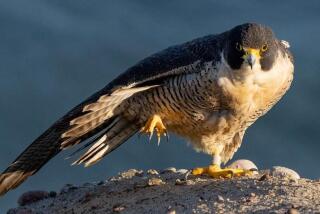Talon Show : Rare Falcon Gives a Soaring Performance
- Share via
Tim Rudnick looks up whenever he hears pigeons fuss.
When he’s lucky, he sees the most fascinating of his neighbors, a rare peregrine falcon that has been hanging around the 300 block of Market Street in Venice. One of the fastest birds in the world, the peregrine can swoop down on a pigeon or other avian entree at speeds up to 200 m.p.h.
Rudnick, 46, first saw the stately bird of prey about three months ago. It was perched on top of the street light in front of his house, a freshly killed pigeon in its talons.
The bird had a helmet of dark feathers and stood more than 12 inches tall. After consulting his field guide to birds, the general contractor and amateur birder realized he was probably standing 15 feet away from a peregrine, one of the nation’s endangered species. “It was a privilege,” Rudnick said.
The peregrine faced extinction in the United States when ingestion of the pesticide DDT caused the birds to lay eggs with shells so thin the chicks rarely survived. As a result of the American ban on DDT in 1972 and the efforts of the Peregrine Fund and other environmental groups, the birds are making a modest comeback.
Lloyd Kiff, acting curator of ornithology at the Los Angeles County Museum of Natural History, said the peregrine is still rare in Los Angeles, although it has largely recovered in Northern California and some other parts of the country.
“There are sightings from time to time--the birds are mostly migrants from the north--but the peregrine is virtually extinct in Southern California as a breeding bird,” Kiff said.
There are about 100 pairs of peregrines in California.
During that first sighting, Rudnick grabbed his camera to preserve the image of the urban hunter. “The bird was still there after I went to the store to buy film,” Rudnick recalled. He showed the photos to biologists at Santa Monica College, who confirmed his identification of the large raptor.
Rudnick, who saw the bird last week for the fourth time, is sure it lives somewhere in the neighborhood.
“If you removed all the houses, we would be in an estuary, which would be the natural habitat for this kind of bird,” said Rudnick, who lives three blocks from the beach.
Kiff said peregrines, which eat only birds, like to hunt in wetlands. The birds typically lay their eggs on cliff ledges, but in cities they sometimes “set up housekeeping,” as Kiff put it, on the ledges of skyscrapers. “To a peregrine, a tall building is just another cliff.”
“Peregrines are recovering in this area,” said Kiff, who has studied the local history of the birds. Before DDT was introduced in 1947, there were six known nesting pairs in Los Angeles County. All were lost during the 1950s. In 1981 Kiff and other friends of the peregrine began releasing several birds a year in Westwood, hoping the peregrine would re-establish itself locally.
Three Pairs
Today, Kiff said, three known breeding pairs are in the metropolitan area. One pair live on the Federal Building in the Miracle Mile district, one on a downtown high-rise and one on the Vincent Thomas Bridge in San Pedro. Since peregrines establish a rather large territory, Kiff speculated that the peregrine Rudnick has seen may be one of the Federal Building birds that flies to Venice to hunt.
Peregrines continue to be plagued by fragile eggs, Kiff said, especially in Southern California where high concentrations of DDT persist. To improve the birds’ chances of survival, the Peregrine Fund collects their eggs, replacing them with dummy eggs made of plaster of Paris and painted reddish brown. “The birds don’t know the difference,” Kiff said. “Birds are not the most intelligent things.”
After incubating the eggs, the environmentalists distribute the young among the parental nests, often mixing up the offspring to encourage genetic diversity.
Because of the peregrine’s fondness for pigeons, it is unpopular among those who raise pigeons commercially or for show. Kiff said that locally the friends of the peregrine and the pigeon fanciers have reached a kind of truce. In Los Angeles peregrine eggs are collected but are not replaced with live young because, Kiff said, “it’s feared they would be shot.” For their part, the pigeon fanciers leave the adult peregrines alone.
Whenever Rudnick spots his neighborhood peregrine, he drops whatever he’s doing to watch it. “It’s like a visitation,” said Rudnick, who resorts to poetry to describe his feelings about the bird.
Rudnick said he has seen Venice become more and more urbanized during the 20 years he has lived there.
“To me the peregrine is like a phoenix,” he said. “It’s a proof to me that nature survives the city.”
More to Read
Sign up for Essential California
The most important California stories and recommendations in your inbox every morning.
You may occasionally receive promotional content from the Los Angeles Times.










